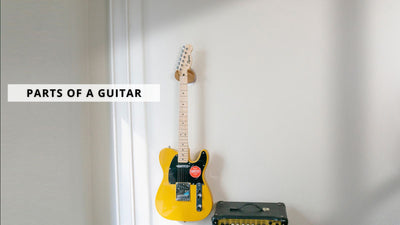Exploring the Parts of a Guitar: Understanding Its Key Components

The guitar, with its timeless appeal and universal popularity, is a musical instrument that has captivated musicians and enthusiasts for centuries.
Whether you're a seasoned guitarist or a novice looking to start your musical journey, understanding the various parts of a guitar is fundamental.
In this blog, we'll embark on a journey through the intricate anatomy of this beloved instrument, breaking down its key components and their roles in producing the beautiful melodies that have defined generations of music.
The Body

The body of a guitar is its defining feature, responsible for shaping its sound and determining its tonal qualities.
Guitars come in various shapes and sizes, with the most common being the dreadnought, concert, and jumbo.
Each shape offers distinct sound characteristics, but they all consist of several crucial elements:
a. Top (Soundboard):
The top of the guitar, often made of spruce, cedar, or other tonewoods, is responsible for producing the primary sound of the guitar. It vibrates when the strings are plucked, creating the initial sound that resonates throughout the instrument.
b. Back and Sides:
The back and sides of the guitar are typically made from various types of wood, such as mahogany, rosewood, or maple. They reflect and amplify the sound produced by the top, contributing to the guitar's overall tone and projection.
c. Soundhole:
The soundhole on the top of the guitar allows the sound to escape and be heard. It also plays a role in shaping the guitar's tone by influencing the resonance of the instrument.
Neck and Headstock

Moving from the body we will encounter the next crucial parts of a guitar that govern playability and tuning:
a. Neck:
The neck of a guitar is a long, slender piece that connects the body to the headstock.
It is typically made of wood, such as maple or mahogany, and provides stability and support for the strings.
The neck's shape and profile can significantly impact the comfort and feel of the guitar for the player.
b. Fretboard (or Fingerboard):
The fretboard is a flat, often dark-colored surface on the front of the neck. It features metal frets, which are the divisions that mark different notes along the neck.
Players press down on the strings behind the frets to change the pitch of the notes produced.
c. Headstock:
The headstock is the top section of the neck, and it plays a vital role in tuning the guitar.
It contains tuning pegs or machine heads, which adjust the strings' tension, thereby tuning the guitar to the desired pitches.
Strings
Strings are the heart and soul of a guitar, and they are responsible for producing the notes and chords that define its music:
a. Number of Strings:
Guitars typically have either six or twelve strings. Acoustic and electric guitars commonly have six strings, while twelve-string guitars are known for their fuller and jangly sound, created by doubling each of the standard six strings with a thinner octave string.
b. String Materials:
Guitar strings can be made from various materials, including steel, nylon, and a combination of both.
Steel strings are common on acoustic and electric guitars, providing a bright and vibrant tone, while nylon strings are commonly found on classical guitars, offering a mellower and softer sound.
c. Tuning:
Standard guitar tuning for a six-string guitar, from low to high, is E-A-D-G-B-E. Different tunings, such as drop D or open G, can be used to achieve specific musical effects and styles.
Bridge and Saddle

The bridge and saddle are important Parts of a guitar that affect string tension, intonation, and transfer of vibrations:
a. Bridge:
The bridge is located on the guitar's top and serves as an anchor point for the strings.
It transfers the vibrations from the strings to the guitar's body, enhancing the resonance and volume of the instrument.
b. Saddle:
The saddle is a small piece that sits atop the bridge. It is responsible for setting the string height and spacing, affecting playability and intonation.
Adjusting the saddle can help fine-tune the guitar's performance.
Pickguard
The pickguard is a protective piece often made of plastic or other materials, and it is located on the front of the guitar's body, beneath the soundhole.
Its primary purpose is to guard against damage caused by the player's strumming or picking hand.
Additionally, it can serve as an aesthetic element, adding to the guitar's overall visual appeal.
Electronics (in Electric Guitars)
Electric guitars are equipped with electronic components that allow them to be amplified and shaped for various styles and genres.
These components include pickups, controls, and output jacks. Pickups capture the vibrations of the strings and convert them into electrical signals, which are then sent to an amplifier for sound projection.
Electric guitars typically have volume and tone controls, allowing players to adjust the sound's character and intensity.
Conclusion
In conclusion, understanding the various parts of a guitar is essential for anyone looking to embark on a musical journey or deepen their appreciation of this iconic instrument.
From the body and neck to the strings and electronic components in electric guitars, each part plays a crucial role in shaping the guitar's sound, playability, and aesthetics.
Whether you're a beginner or an experienced guitarist, this knowledge can enhance your appreciation of the guitar's intricate design and inspire you to explore its limitless musical possibilities.
So, pick up your guitar and start strumming, and let the harmony of its parts create beautiful music.
